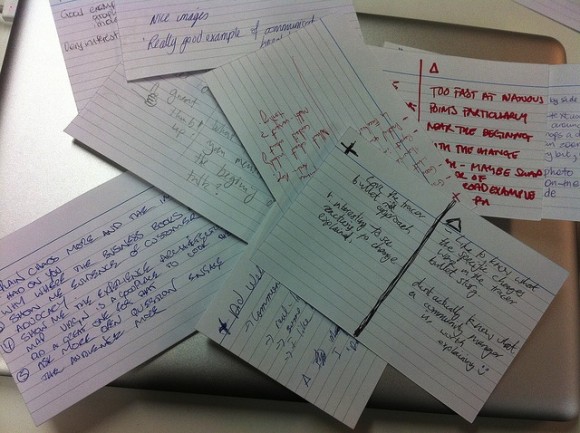There are a few tools I use on an almost weekly basis. Some of these help me get more stuff done, some of them help me do things better. One of these tools is Plus/Delta.
Plus/Delta is dead-simple. Two columns, one labeled “Plus” and one labeled “Delta.” You can do it on a whiteboard, on a collaborative Google Doc (here’s one), on paper, on Post-Its or on index cards. Have a facilitator scribe, or have the participants write their Plusses and Deltas on notecards or on Post-Its. Have the participants in the session articulate what worked well (“Plus”) and what they would change for next time (“Delta”). Capture everything, summarize the key points, learn from it and iterate. The whole process shouldn’t take more than 10-15 minutes.
It pretty much works with any size group; I’ve used it in groups up to about twenty or so. If the group is really large, break it into smaller subgroups and have each group do its own Plus/Delta. Then have each group pick a representative to share their results to everyone in the larger group in turn.
Plus/Delta works best when you make it a default part of a process. It’s just “the thing you do after you did something else.” For example:
- Did you just do a two-day workshop? Have the participants engage in Plus/Delta near the end of the second day in order to understand how to do a better workshop next time.
- Did you invest time to go to a conference? Plus/Delta.
- Did your team pitch a project to a client? What do you do when you get back to the office? Plus/Delta.
- How did that last development sprint go? Plus/Delta.
- Is that an antelope driving a car?
Plus/Delta.(Nope. Chuck Testa.)
You can learn more about Plus/Delta in the book Gamestorming, by Dave Gray, Sunni Brown and James Macanufo. It’s one of dozens of tools in the very rich Gamestorming tool kit.
By the way, this post came about as part of the Weekly Post Challenge, proposed by Dre Armeda. You can find a few other posts from this week by Mendel Kurland, Kelley Koehler, Chris Ford, Matt Medeiros, Dre Armeda and an epic post from John Hawkins on how to produce a podcast.
image: Johanna Kollmann via cc by 2.0

This is a great tip, Chris. Thanks for sharing it.
You’re welcome, Matt!